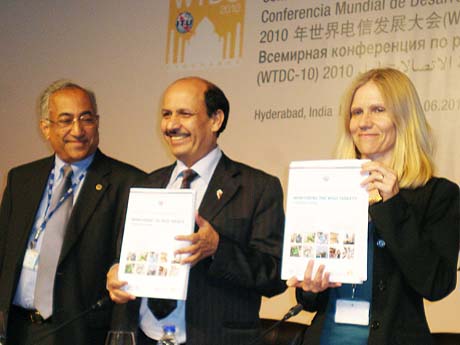
The International Telecommunication Union’s World Telecommunication/ICT Development Report 2010 has reviewed the world’s progress made towards creating a global information society by 2015, a commitment that governments agreed upon at the World Summit on the Information Society (WSIS) which took place in Geneva in 2003 and in Tunis in 2005.
We bring you key findings ( below) and a link to the 28 page executive summary “Today, nearly 90 per cent of the world’s population is covered by a mobile cellular network,” says ITU Secretary-General Hamadoun Touré, “and even people in rural and remote areas now have the means to access the global information society”. The world’s two most populous countries in the world — India and China —mobile technology have provided basic telephone services to over 90 per cent of villages. In many developing countries, fixed telephone lines are largely limited to urban areas. But today, more than half the rural households have a mobile telephone.
“The number of Internet users has more than doubled since 2003, when the World Summit on the Information Society first met, and today more than 25 per cent of the world’s population is using the Internet,” adds Sami Al Basheer Al Morshid, Director of ITU’s Telecommunication Development Bureau. “The importance of bringing people online is widely recognized, but more efforts are needed to increase the number of Internet users. While today 75 per cent of all households have a TV, only 25 per cent have Internet access. In the developing countries, home Internet penetration is as low as 12 per cent.”
Where home access to the Internet is low, it is particularly important for countries to invest in public Internet access. Many governments across the world are actively promoting public access and some are turning libraries, museums and post offices into Internet cafés. In Bhutan, for example, 40 per cent of all localities have a Public Internet Access Centre. Since 2003, the Royal Government of Bhutan, in cooperation with ITU, has been revamping post offices in remote and rural locations into ICT centres, allowing rural inhabitants to join the information society.
The report finds that the availability of ICTs in health institutions in developing countries is limited and more needs to be done to achieve the target of “connecting all health institutions to the Internet”, ideally through broadband. M-health, which refers to medical and public health practices that are supported by mobile devices, is another area with great potential and the report highlights that over 75 per cent of countries today have launched some m-health initiatives. This includes, for example, the use of text messages in South Africa, to support HIV/AIDS treatment.
Since WSIS, much progress has been made in the area of e-government. The target set by the Summit to “connect all local and central government departments” has been at least partially achieved, since almost all central governments have a web presence and provide basic information to their citizens. The next step is to ensure that all countries move towards more sophisticated and interactive online e-government applications and services, for example, to apply for a driver’s license, fill out a tax form, or to make online payments using a credit or debit card.
A central focus of the WSIS commitments is to bring schools online and to ensure that school curricula teach students how to use ICTs. Here, the report finds mixed results. While many schools in developing countries remain deprived of any form of Internet access, a number of countries have successfully brought ICTs to schools. Jordan, for example, has connected 80 per cent of its schools to the Internet and 73 per cent have a broadband connection. Its teaching force is highly qualified in the area of IT and the large majority of the country’s schools make use of Internet-assisted-instruction.
The report further points to the lack of local content, in local languages on the Internet. The web is still largely dominated by the English language, even though only around 15 per cent of the world’s population understands it. On the other hand, the proportion of English-speaking Internet users is declining, suggesting that non-English speakers are increasingly going online. Another indication for the diversification of content on the Internet is the growing number of websites that are registered under country domain names. Some of the highest 2005-2009 growth rates in terms of newly registered domain names were found in India (.in), Russia (.ru) and China (.cn).
Goal to provide high speed online access to half the world’s population by 2015
Overall, the report concludes that while major achievements have been made over the past five years, substantial efforts are required in developing countries to achieve the goals and targets by 2015.
The report is the result of a joint effort among several international organizations, led by ITU, and includes contributions from UNESCO, WHO and UNDESA, as well as from representatives of civil society. It reviews each of the ten targets agreed upon at the World Summit on the Information Society, which range from connecting villages, schools, health centres, libraries and government agencies to information and communication technologies (ICTs) and to developing online content. It is the first global effort to identify quantitative measures to show how far the world has come in building an information society, and what remains to be done.
28-page PDF document with Executive summary: http://www.itu.int/dms_pub/itu-d/opb/ind/D-IND-WTDR-2010-SUM-PDF-E.pdf
June 2 2010